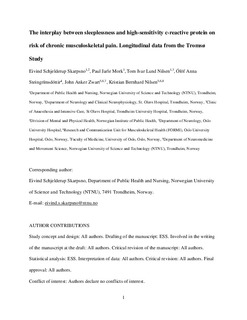| dc.contributor.author | Skarpsno, Eivind S. | |
| dc.contributor.author | Mork, Paul Jarle | |
| dc.contributor.author | Nilsen, Tom Ivar Lund | |
| dc.contributor.author | Steingrímsdóttir, Ólöf Anna | |
| dc.contributor.author | Zwart, John Anker | |
| dc.contributor.author | Nilsen, Kristian Bernhard | |
| dc.date.accessioned | 2020-01-14T10:30:35Z | |
| dc.date.available | 2020-01-14T10:30:35Z | |
| dc.date.created | 2019-07-26T12:47:23Z | |
| dc.date.issued | 2019 | |
| dc.identifier.citation | Sleep. 2019, 42 (9), . | nb_NO |
| dc.identifier.issn | 0161-8105 | |
| dc.identifier.uri | http://hdl.handle.net/11250/2636155 | |
| dc.description.abstract | Study Objectives To examine independent associations of sleeplessness and high-sensitivity C-reactive protein (hsCRP) with risk of chronic musculoskeletal pain, and to explore the joint effect of sleeplessness and hsCRP on risk of chronic musculoskeletal pain. Methods A population-based prospective study of 3214 women and 3142 men (mean age: 55.4, range: 32–87) without severe chronic musculoskeletal pain and with hsCRP ≤ 10 mg/L at baseline in 2007–2008. Modified Poisson regression was used to calculate adjusted risk ratios (RRs) with 95% confidence intervals (CIs) for any chronic musculoskeletal pain and chronic widespread pain (CWP) at follow-up in 2015–2016 associated with self-reported sleeplessness and hsCRP at baseline. Results Compared with persons without sleeplessness, women and men reporting often/or always sleeplessness had RRs of CWP of 2.53 (95% CI: 1.94–3.29) and 2.48 (95% CI: 1.63–3.77), respectively. There was no clear association between hsCRP and risk of any chronic musculoskeletal pain or CWP. Joint effect analyses using persons without sleeplessness and with a hsCRP < 1.00 mg/L as the reference gave RRs for chronic musculoskeletal pain of 1.73 (95% CI: 1.26–2.37) for those with often/always sleeplessness and hsCRP < 1.00 mg/L; 1.01 (95% CI: 0.78–1.32) for those without sleeplessness and hsCRP ≥3.00 mg/L; and 2.47 (95% CI: 1.79–3.40) if they had both often/always sleeplessness and hsCRP ≥ 3.00 mg/L. The corresponding RRs for CWP were 1.89 (95% CI: 1.27–2.83), 0.96 (95% CI: 0.68–1.37), and 2.83 (95% CI: 1.91–4.20), respectively. Conclusions These results suggest that there is an interplay between sleeplessness and hsCRP on risk of any chronic musculoskeletal pain and CWP. | nb_NO |
| dc.language.iso | eng | nb_NO |
| dc.publisher | Oxford University Press | nb_NO |
| dc.title | The interplay between sleeplessness and high-sensitivity C-reactive protein on risk of chronic musculoskeletal pain: longitudinal data from the Tromsø Study | nb_NO |
| dc.type | Journal article | nb_NO |
| dc.type | Peer reviewed | nb_NO |
| dc.description.version | acceptedVersion | nb_NO |
| dc.source.pagenumber | 8 | nb_NO |
| dc.source.volume | 42 | nb_NO |
| dc.source.journal | Sleep | nb_NO |
| dc.source.issue | 9 | nb_NO |
| dc.identifier.doi | 10.1093/sleep/zsz127 | |
| dc.identifier.cristin | 1712889 | |
| dc.description.localcode | Locked until 28.5.2020 due to copyright restrictions. This is a pre-copyedited, author-produced version of an article accepted for publication in Sleep following peer review. The version of record is available online at: [10.1093/sleep/zsz127]. | nb_NO |
| cristin.unitcode | 1920,16,0,0 | |
| cristin.unitcode | 194,65,20,0 | |
| cristin.unitcode | 1920,28,0,0 | |
| cristin.unitcode | 194,65,30,0 | |
| cristin.unitname | Nevroklinikken | |
| cristin.unitname | Institutt for samfunnsmedisin og sykepleie | |
| cristin.unitname | Klinikk for anestesi og intensivmedisin | |
| cristin.unitname | Institutt for nevromedisin og bevegelsesvitenskap | |
| cristin.ispublished | true | |
| cristin.fulltext | postprint | |
| cristin.qualitycode | 1 | |
